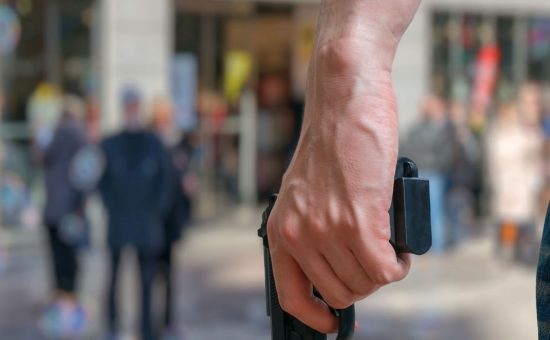“At-risk” and “sign language interpreter” are not synonymous for most people. Stephen Holter highlights some risk factors and preventative measures sign language interpreters can use to stay safe.
- Walking through the lobby of the mental health facility, the sign language interpreter had no way of knowing that just a few short hours later, a gunman would open fire, killing the receptionist and injuring several others before turning the gun on himself.
- At a university campus in a different part of the country, a female interpreter is walking to her car after completing her night class assignment when she notices a male student from the class following her. Fearing for her safety, she reaches for her phone to call the police.
- While on assignment interpreting a potentially volatile home visit for a social worker, an interpreter has a feeling of concern for her own safety after noticing that the door is locked behind her.
- While walking through the hall in a jail, a sign language interpreter is told by the guard that, if he tackles her, it will be for her own safety.
- In a psychiatric facility, an interpreter is suddenly assaulted. She has not been provided with a “panic button” that is routinely supplied to all other hospital staff in the event of such an attack.
All of these situations are real and were provided by working sign language interpreters discussing personal safety concerns that exist on the job as part of their daily work.
Personal Security and Sign Language Interpreters
A number of factors make the field of sign language interpreting unique in terms of personal security. Freelance interpreters are frequently called upon to work in novel settings at any hour of the day or night. The interpreter is often “alone” in the sense that they are not with others who are known to them. Some settings can be inherently dangerous.
Sign language Interpreters frequently work in healthcare and social service settings. In 2013, the Bureau of Labor Statistics reported more than 23,000 significant injuries due to assault at work. More than 70 percent of these assaults were in healthcare and social service settings. Health care and social service workers are almost four times as likely to be injured as a result of violence than the average private sector worker. (OSHA Updates)
In recent conference workshops, sign language interpreters were asked about the types of settings in which they experienced safety concerns. The most frequently mentioned setting was mental health hospitals. With HIPAA law, interpreters are often given little to no information about the patient. When this is the case, the interpreter may not be aware of the presenting concerns that led to the hospitalization of the patient. It may be the case that it is not the patient with whom the interpreter is working that is a danger, but rather others in the environment. Sign language interpreters who find themselves working in mental health settings would benefit from seeking out professional development opportunities that address working with individuals whose behaviors are escalating to the point of potential violence.
What Can Sign Language Interpreters Do to Stay Safe?
While risks may be present in any number of settings that sign language interpreters work, there are some steps that may be taken to keep oneself safe. These include the following:
a. Situational Awareness
Regardless of the setting in which an interpreter works, a key factor that will help to keep one safer is situational awareness. This seems, of course, to be common sense but is often discounted. Maintaining alertness to what is occurring in your immediate environment will provide you with time to see approaching danger, react, and attempt to get away from potential sources of threat.
To practice developing situational awareness, one important habit is to begin assessing the environment you will be working in upon entering to identify at least two ways to exit the scene if a crisis starts to occur. For example, when interpreting for political candidates or concerts, the interpreter should be in the practice of locating the two nearest exits. Planning ahead will reduce confusion in the event there is a crisis and one of the exits is blocked.
b. Plug Into Notification and Alert Systems
University settings now have alert systems to notify staff and students of situations such as active shooter warnings. Contract interpreters, however, are often not “plugged” into the system to receive such notifications. One solution that has been discussed is ensuring that the agency that contracts with sign language interpreters is, in fact, set up on that system so that they may notify the interpreter of any such emergencies.
c. Be Your Own Bodyguard
As discussed in “Fight like a Girl…and Win; Defense Decisions for Women,” it is important to decide that one is one’s own bodyguard. It is good to have police and other first responders, but it takes time for them to respond and, by then, it may be too late. Realizing that there needs to be a certain degree of self-reliance is the first step to keeping safe.
d. Avoid Complacency
Complacency is clearly one of the greatest factors that compromise situational awareness. As sign language interpreters are racing from one assignment to the next, it is natural to be focused on reading text messages or catching up on voicemails. Attackers will look for easy targets. A person whose attention is focused on the phone is an easy target. In his book, “The Gift of Fear,” Gavin DeBecker discusses how, rather than giving way to complacency, part of staying safe is tuning into the danger signals that may be provided by one’s own senses.
Interpreters should consider the anticipated length of an assignment when parking. For example, rushing to interpret an emergency room visit, the interpreter might be focused on the potential nature of the emergency. ER visits, however, may often run four or five hours. As such, the lighting in the area where the interpreter has parked may have changed considerably. This should be taken into account for all settings.
e. Stay Physically Fit
How can one become a less desirable target for a potential attacker? Attackers often want to have the greatest reward with the least amount of risk. Physical fitness comes into play in this regard as attackers will often prey on those whom they regard to be easy targets. If one is looking for a reason to get into better shape, this may be it. When looking at workout options, one form of training that may be sought is called Krav Maga. This is a defensive training which not only provides a physical workout, but also provides skills for defending oneself against varying types of physical assaults, including those involving weapons.
f. Utilize Non-Lethal Tools
Some people choose to carry non-lethal self-defense tools such as pepper spray/gel, taser, and a Kubaton. These tools all have relative pros and cons. While none of these tools above will incapacitate the attacker, they are, instead, used to momentarily stop the attacker long enough for one to get a safe distance away.
Pepper spray or gel: Pepper spray is small and portable and is available in containers that may look like lipstick. Pepper spray has a range of 8-20 feet and typically costs below $30. One drawback of pepper spray is that it may be affected by wind and be blown back into one’s own face. Pepper gel is now available that is not as subject to gusts of wind. These devices have safety locking mechanisms that require enough familiarity to be operated when one is panicked. Additionally, it will be important to retain control of the spray so that it may not be taken by the attacker and used on the victim.
Stun guns: Stun guns are a potentially effective means of incapacitation. Like pepper spray, stun guns are also fairly inexpensive and portable. While pepper spray is to be used at a distance, a stun gun requires that one must be close enough to make contact with the attacker. Effectiveness of a stun gun, or lack thereof, also depends on battery life. As with pepper spray, one also need to be able to retain control of the device.
Kubotan: Another self-defense tool is called a Kubotan. Looking like a pen made of hard plastic or metal, a kubotan may be attached to a keychain for easy access. A kubotan may be used for strikes against joints or fleshy areas for self-defense.
Conscious Consideration is the Key
As evident in the points that were discussed above, self-protection for a sign language interpreter involves multiple dimensions. It begins with an awareness that some settings may be more inherently dangerous than others. Regardless of the setting, however, maintaining a situational awareness to dangers that may suddenly arise will give you more time to formulate a response that will get you out safely. With the dangers present in today’s world, giving conscious consideration to self-protection is time well spent.
There are multiple aspects that come into play when trying to keep oneself safe as a working interpreter. It begins with the awareness that one may be at risk, maintaining vigilance to recognize when danger might be approaching, and learning physical strategies that might be used in the event they are needed. By using this multi-tiered approach, sign language interpreters can enhance their ability to keep themselves safe.
Questions to Consider:
- What potential security risks do you see while traveling to or within your work settings?
- How do you think you can reduce each of these risks?
- What local resources are available to you to increase your personal safety knowledge and skills?
References:
Becker, G. D. (1997). The gift of fear: Survival signals that protect us from violence. Boston: Little, Brown.
Gervasi, L. H. (2007). Fight like a girl– and win: Defense decisions for women. New York: St. Martin’s Griffin.
OSHA guidelines for preventing workplace violence for … (2015, April 01). Retrieved September 2, 2016, from https://www.osha.gov/SLTC/workplaceviolence/evaluation.html










